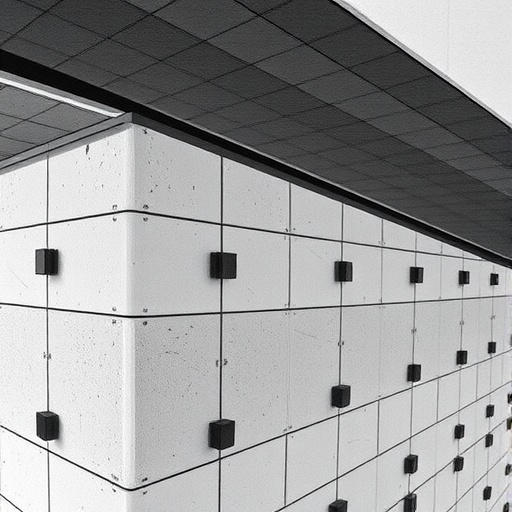In an impressive stride toward enhancing the durability and functionality of concrete as a construction material, researchers Ozturk and Akis have introduced an innovative method of self-sensing that employs intrinsic capacitance and resistance. This pioneering research, detailed in their recent publication, demonstrates how concrete can be transformed into a smart material capable of detecting its own load and deformation in real-time. The implications of this breakthrough extend beyond mere structural integrity, potentially revolutionizing how we approach environmental monitoring, safety protocols, and maintenance in civil engineering.
The innovation presented by Ozturk and Akis stems from the pressing need to advance traditional construction methods, which often rely on manual inspections and outdated monitoring techniques. Concrete structures, which are pivotal in modern construction, frequently suffer from undetected external forces and stressors that can lead to catastrophic failures. By integrating self-sensing capabilities into concrete, the researchers have addressed this critical gap in existing infrastructure monitoring systems. Their approach signals a transformative change, promising not just improved safety, but also significant cost savings over the lifespan of concrete structures.
The researchers utilized the intrinsic properties of concrete materials, particularly their capacitance and resistance characteristics, to create a system wherein the concrete itself can monitor stress levels and detect deformations. This self-awareness is achieved through a complex interplay between the physical properties of the concrete mix and advanced material science techniques. By exploring the relationship between the applied load and the resulting changes in capacitance and resistance, they were able to develop a model that exhibits sensitivity to changes in structural health.
Capacitance in this context relates to the ability of the concrete to store electrical charge, while resistance pertains to the material’s opposition to electrical flow. The study illustrates how variations in these two properties can be correlated to the mechanical stress experienced by the material. For instance, when additional weight is applied to a concrete beam, this load alters the electrical properties, signifying a change that can be effectively monitored. This nuanced understanding of the material’s behavior under stress represents a considerable advancement in the field of materials engineering.
Moreover, the implementation of such self-sensing technologies holds great promise for the construction industry. With proactive monitoring capabilities, engineers can detect potential issues before they escalate into significant structural failures. In scenarios where concrete begins to weaken or deform under pressure, the self-sensing system would alert civil engineers to the need for further inspection or maintenance, thus enhancing the safety and operational lifespan of structures.
This innovative method of integrating self-sensing within concrete could also lead to substantial advancements in sustainable construction practices. By facilitating real-time monitoring, it reduces the necessity for excessive resource expenditure on maintenance and inspections. This not only promotes a more environmentally friendly approach but also ensures that infrastructure is maintained efficiently and economically.
Importantly, the implications of self-sensing concrete extend into various domains, including transportation, public infrastructure, and even disaster management. In bridges and high-traffic areas, having a robust system that can signal when repairs are needed translates to optimally safe structures and minimizes accidents that can arise from undetected deterioration. Such preventive measures can lead to improved public safety and a reduction in financial losses associated with structural failures.
The research led by Ozturk and Akis represents a paradigm shift in concrete science, emphasizing a future where construction materials serve multifunctional purposes. Through advancements in materials science, this self-sensing capability aligns with broader technological trends—such as the Internet of Things (IoT)—that aim to integrate smart technologies within conventional practices. The data garnered from such concrete systems can potentially be aggregated and analyzed, allowing for a comprehensive understanding of the structural health across vast networks of infrastructure.
While the deployment of self-sensing concrete is still in its infancy, the groundwork laid by Ozturk and Akis provides a solid foundation for future research and development in this field. As more studies emerge showcasing the effectiveness and practicality of such systems, we may witness a significant shift toward integrating smart technologies into the fabric of our built environment. The journey toward realizing full-scale adoption of self-sensing concrete will require collaboration among scientists, engineers, and industry stakeholders to address challenges related to scalability and implementation in real-world conditions.
In conclusion, Ozturk and Akis’ work signifies a monumental leap in concrete technology, heralding an era of enhanced construction materials that are not only robust and durable but also intelligent. Their research encapsulates the spirit of innovation intrinsic to materials science, suggesting that the concrete structures of tomorrow could be as dynamic and responsive as the environments in which they are placed. By harnessing the inherent properties of concrete, their findings lead us to reconsider not only how we build but how we maintain safety, efficiency, and sustainability in our urban landscapes.
Subject of Research: Self-sensing of load and deformation in concrete using intrinsic capacitance and resistance.
Article Title: Self-sensing of load and deformation in concrete using intrinsic capacitance and resistance.
Article References: Ozturk, M., Akis, A. Self-sensing of load and deformation in concrete using intrinsic capacitance and resistance. Sci Rep 15, 39911 (2025). https://doi.org/10.1038/s41598-025-23576-w
Image Credits: AI Generated
DOI: https://doi.org/10.1038/s41598-025-23576-w
Keywords: Self-sensing concrete, intrinsic capacitance, resistance, structural health monitoring, smart materials, concrete technology, material science, environmental monitoring, safety, construction innovation.




